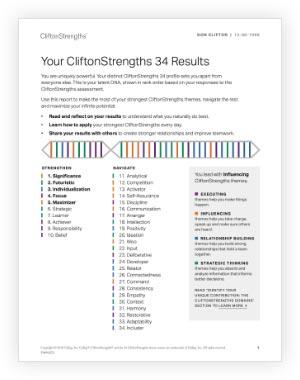Story Highlights
- 360 feedback can be difficult to accept and address
- Strengths-based feedback can increase performance and engagement
- Leaders can harness strengths to help overcome their shortcomings
Discussing 360-degree feedback can be a painful exercise -- for the feedback giver and receiver. We all want to know how we're doing, and 360-degree feedback has proven benefits. Yet it can be difficult to accept constructive input from colleagues, superiors and subordinates.
In my experience as a CliftonStrengths coach, I have found that incorporating CliftonStrengths into 360 feedback conversations encourages leaders to be more receptive and optimistic -- even with particularly harsh feedback.
CliftonStrengths makes 360 conversations easier because it helps leaders identify avenues for growth and overcome challenges with science-based strategies. Gallup has found that teaching people to use their strengths supports their engagement and performance.
That is, when leaders focus on what they do best, they can envision a positive, hopeful path for the future.
In fact, Gallup's strengths meta-analysis shows that employees who receive strengths-based feedback have:
- 8%-18% increased performance
- 2%-10% higher customer metrics
- 20%-73% lower attrition
- 7%-23% higher employee engagement
- 4%-10% increased citizenship
Here's an example to illustrate. One leader I was coaching received the following comment in their 360 feedback: "Needs to listen more." Rather than spinning our wheels to "fix" this weakness, we talked about how their natural strengths -- such as high Empathy talent -- could help them demonstrate that they value employees' opinions.
The manager walked away from the 360 with not only resources for listening, but also confidence in their natural ability to show employees that their ideas matter.
Here are three benefits of incorporating CliftonStrengths into 360-feedback conversations that I have witnessed in my work coaching Gallup clients.
Three Benefits of a Strengths-Based Approach to 360s
-
CliftonStrengths promotes self-awareness and confidence.
When we know our top strengths, we understand how we approach relationships, tasks and challenges (at work and in life). Being aware of our natural inclinations helps us view constructive feedback as a tool for growth -- rather than a personal insult.Consider the leader who "needs to listen more." Communication is their No. 1 CliftonStrength and helps them skillfully convey strategies and information to others. This leader's team benefits enormously from this talent. However, the leader tended to fill silence rather than give team members space to share their perspectives. For this leader, recognizing blind spots with their Communication talent provided context and self-awareness that was disarming and focused their efforts.
Strengths helps leaders approach 360-degree feedback conversations in a future-focused, action-oriented manner. In turn, leaders are more open and receptive to feedback -- which helps them develop (and own) a plan for improvement.
-
CliftonStrengths promotes meaningful action.
A tailored approach to leadership development promotes lasting growth more effectively than one-size-fits-all techniques. CliftonStrengths provides the perfect framework for individualized development because it's all about what each person uniquely does best.A customized strengths-based plan shows leaders how to harness their natural strengths to overcome shortcomings. For instance, perhaps a leader with low Adaptability talents struggles with leading change. This individual might benefit from using their Learner talents instead to experiment, innovate and brainstorm more -- and avoid change hesitancy.
In other words, strengths helps the individual arrive at an outcome by following the path that suits who they are as a person. And it's the most engaging and effective way to develop.
Forging partnerships with people with complementary strengths is another proven way to enhance areas of opportunity from 360 feedback. For example, a leader who struggles with organization and planning might benefit from collaborating with an individual who enjoys detail, planning and bringing order to complex situations.
-
CliftonStrengths boosts accountability.
Leadership development is a journey, and improving 360-feedback scores takes time. CliftonStrengths facilitates ongoing goal-setting and accountability -- not only because it inspires and motivates leaders, but also because it provides a framework for consistent coaching conversations.Leaders should participate in a planned coaching journey that incorporates several CliftonStrengths coaching sessions with their coach. During these conversations, leaders can assess progress, discuss barriers, celebrate breakthroughs and recalibrate goals.
As a leadership coach, I've found that strengths helps my clients to feel excited about 360-degree feedback. They're enthusiastic about setting strengths-based goals because those goals are authentic to who they are -- so they feel achievable. Connecting goals to strengths results in personal, tailored targets that leaders are more committed to and confident in.
For these leaders, accountability isn't intimidating. Just the opposite: Ongoing strengths conversations fuel momentum and energize leaders to pursue positive change.
Next Steps: Start With Discovering Your Full 34 CliftonStrengths
In my work with clients, I recommend that leaders participate in several dedicated CliftonStrengths coaching sessions prior to reviewing 360-degree feedback. These first conversations allow them to focus on understanding self, goals and purpose. These conversations provide transformational self-discovery and leave leaders eager to receive feedback from others.
Next, leaders should seek 360 feedback and pair that feedback with coaching conversations. Coaching helps them process what they've learned, create a plan that aligns with their strengths and personal goals, and take into account how their key stakeholders may perceive them.
In future coaching conversations, the individual's supervisor can be included to discuss successes, calibrate goals and brainstorm about actions. This promotes accountability for the individual -- and just as importantly, it encourages managers to facilitate the five coaching conversations which stoke development.
In the best workplaces, leaders use 360 feedback as a tool for development, not simply as a performance indicator. While metrics and outcomes matter, real growth occurs when you value the person and their one-of-a-kind growth journey.
Tap into leaders' natural strengths to help them grow, and lasting business transformation will be the outcome.
Become a better leader by leaning into your strengths:
- Subscribe to the CliftonStrengths newsletter to receive monthly insights and advice.
- Discover how learning your strengths can help you succeed in work and life.
- Take the CliftonStrengths 34 assessment to unlock your full strengths profile and more.
Gallup®, CliftonStrengths® and each of the 34 CliftonStrengths theme names are trademarks of Gallup. Copyright © 2000 Gallup, Inc. All rights reserved.





